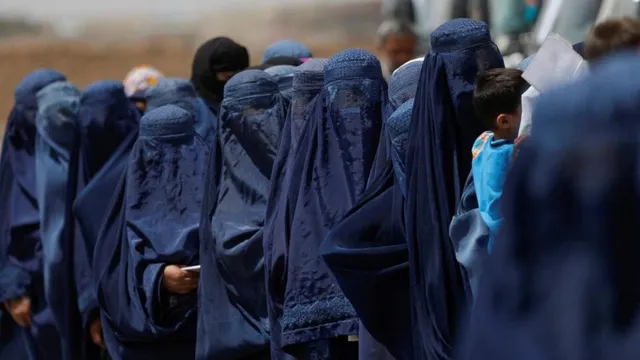- By Sandhya Jain
- Wed, 15 Oct 2025 02:17 PM (IST)
- Source:JNM
The uproar over the exclusion of women journalists from the Taliban foreign minister Amir Khan Muttaqi’s press conference at the Afghan embassy on October 10, 2025 has had the salutary effect of the delegation arranging another meeting and including women journalists on October 12, 2025. Here, women journalists occupied the front row with élan, no veil, no head-covering, hair short or long as per their choice.
While the October 12 meeting is a victory for Indian women journalists, the situation of Afghan women and girls is dire. This, and the initial exclusion of Indian women journalists, calls for introspection by the Islamic world, especially given the sharp contrast between the status of women under the Taliban since 2021, and the rise of women under successive monarchs in Saudi Arabia, where the faith was born.
Briefly, under the Taliban version of Sharia, women and girls have been barred from school and higher education, employment, and public life. They cannot leave the home without a male guardian. The full burqa imposed on them has a unique innovation – one eye opening has to be sealed (to further restrict their freedom of movement). Books authored by women have been banned in Afghan universities, along with courses on Gender, Human Rights, Afghan Constitutional Law, among others. It is literally the Stone Age for Afghan women.
In contrast, women in Saudi Arabia have experienced many positive changes over the years. In 2018, Saudi women were allowed to drive, and in 2019, women above the age of 21 years could apply for a passport and travel without the permission of a male guardian. Since 2021, women have been permitted to go to Mecca to perform Hajj without a male relative, provided they are travelling with other women.
The traditional Saudi doctrine of guardianship (wilaya) meant that every woman had a male guardian who took decisions on her behalf – father, husband, or brothers, sons, uncles and even male judges. But since 2019, women above 21 years no longer need a guardian’s approval to access healthcare, education and state services, take up a job or make medical decisions about pregnancy and birth. The guardian’s consent is still required to get married, divorced or leave certain institutions (prison, domestic-abuse shelter). But now, women can seek transfer of guardianship if a male guardian is negligent or unjust.
The minimum age for marriage is 18 years, though courts may permit the marriage of a younger woman in some circumstances. Judges can allow women to marry a man of their own choice if the guardian’s objection is “unreasonable”. Husbands cannot verbally divorce their wives; a wife seeking divorce must petition a court on certain grounds.
There have been rapid strides in women’s education. Education is a key part of Vision 2030, and the literacy rate for Saudi women aged 15-24 was close to 100 per cent in 2017, compared to 57 per cent in 1992. Female students comprise more than half of those enrolled at Saudi universities, and Saudi women excel in all areas of academia, from administration and teaching to research (Arab News).
Gender segregation exists, but some universities offer co-educational courses. In 2018, women formed only 15 per cent of the Saudi labour force, but by 2024, they were 34.5 per cent due to “proactive government policies”, rising educational achievements and an increased demand for women workers.
In 2017, women were allowed to apply for jobs and start their own businesses without a guardian’s consent. Since 2018, there have been significant changes in women’s sports. Nearly 70,000 girls watched the nation’s female school soccer league. The Saudi Women’s Premier League has 10 teams, and players are free to choose whether or not to wear a hijab while competing. In 2025, the first dedicated 24-hour women’s sports TV channel was launched in Saudi Arabia.
Crown Prince MbS stated in an interview with the US news program 60 Minutes (2018) that women have the freedom to decide if they wish to wear the black abaya (full-length robe) and niqab (full-face veil). However, both men and women should dress decently in accordance with cultural and religious norms.
According to the Commission on the status of women (CSW 69), Kingdom of Saudi Arabia, 2025, girls have been educated since the foundation of the Saudi state in 1727, in informal classrooms where boys and girls were taught basic subjects, such as math and literature. Formal education began in 1955 with the establishment of Dar Al Hanan Girls’ School in Jeddah. In 1969, the kingdom made all levels of education free for all, with equal access for boys and girls.
The focus on education under the “Saudi Vision 2030” saw the number of female students enrolled in study programs abroad reach 15,675 (including doctorate level; master’s level; bachelor’s level; and diplomas, fellowships, or other programs).
Saudi women are employed in various sectors, including healthcare, sales, and administrative roles, IT, , and even as yoga instructors. Female entrepreneurs comprise almost half of the Kingdom’s SME owners. Overall, Saudi women now comprise 37 per cent of the workforce in the kingdom.
The Taliban regime cites the Sharia to justify the almost total disempowerment of its female population. Riyadh declares the Qur’an and the Sunnah (Prophet Muhammad’s traditions) to be the country’s constitution. How can such disparate policies and practices derive from the same source? Within the subcontinent there have recently been instances of Muslims following the instructions of clerics with peculiar interpretations of the faith that promote social disharmony. The plight of Afghan women is far more serious and the Islamic world cannot ignore it forever.
(The author is a senior journalist. The views expressed are her own.)

